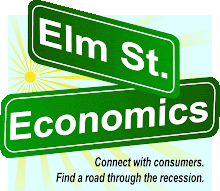One of the reasons so many companies have gotten away with these dramatic discounts is that almost everyone is in the same proverbial boat. Manufacturers and distributors were feeling the hurt every bit as much as the retailer or dealer… so, many of these vendors were providing price-cuts that a re-seller could be passed along to the consumer, thereby absorbing some of the low-price pressure. Everyone in the value chain gets away with price-pointing, as long as nothing upsets the status quo.
An economic recovery is likely to upset the status quo.
As the job market and incomes begin to stabilize, demand for goods will likely increase faster than manufacturers’ ability to produce them, due to the diminished inventory and output capacity of people who provide commodities and products. Many producers—from farmers to refineries to factories—trimmed output in response to the lack of consumer spending. If (when) consumption heats-up faster than production, retail costs will be pushed upward by the simple laws of supply and demand.
Meanwhile, remember that the (U.S.) recession officially started in December of 2007. That means that many companies have spent 18 months now… training customers how to not to pay full price.
Implications: Remember that in marketing, a strategy is why people buy… and a tactic is why they should buy now. If you’re like Wal-Mart, Kia or Southwest Airlines, low price might be a strategy. But for most companies, low price is an occasional tactic designed to help clear-out stagnant merchandise or act as a lost-leader to drive traffic. Not a sustainable means of making a profit.
So here’s the million-dollar question: How (and when) should you transition away from short-term, low-price tactics… and return to a conversation with your consumer that is focused on your unique value proposition?
First, let’s talk about the “how.” What were the benefits sought by customers who bought your product or service… before the recession? What are the triggers that put someone in the market for whatever you sell? Once they’re in the market, what criteria must be met to get on the consumer’s consideration list? What issues will the consumer think about as they narrow the field and make their final decision? What is different about the product line you sell? What is unique about the way you sell it?
Does the thing you sell offer personal gratification, family enrichment, status, shelter, or comfort? Does it represent a way to protect their assets or income… or the opportunity to advance their career? Does it save energy, protect the environment, or help support a worthwhile cause? What is the problem customers are trying to solve when they buy the product or service you sell? What attributes do they seek of a provider in your category? Quality? Service after the sale? Romance? Expertise, a warranty or some other assurance? Flavor? Fast service? Some other value-added component?
Next, let’s think about the “when” part of our question. When is the right time to move from heavy price-point tactics to a conversation about your unique value proposition?
Some pundits would suggest that you time the shift to coincide with a recovery, or just before; advice that is only helpful if you happen to own a crystal ball. As we have said before, most of us will not know that a recovery is underway, officially, until months after it has begun. [See "Dateline 2010," posted 6/20/09.]
I would submit that your unique value proposition (your predominant strategy) should always be a staple component of your marketing effort. Right now, sale prices are everywhere; discounts alone do nothing to make you stand out.
Price has been a valuable tactic, helping many companies bide their time and survive the recession. But if the intent of your marketing is revenue and profit, you must anticipate the possibility of higher costs, and consider how you will regain the fair margins that allow you to operate profitably. In other words, prepare to focus less on how little you cost, and more on how much you are worth.



No comments:
Post a Comment